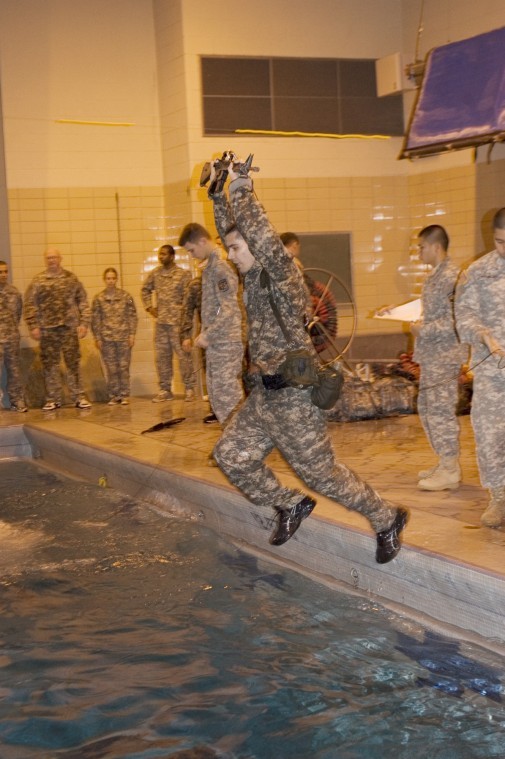ROTC cadets test skills
Daniel Martinez, Freshman computer science major, leaps into the Gabel Hall pool as part of the ROTC water combat training.
November 18, 2010
Clad in full fatigues and gym shoes, NIU Reserve Officers’ Training Corps cadets breathed deeply and took the plunge.
Over 40 ROTC cadets took part in their Combat Water Survival Test (CWST) as part of their commission requirements Thursday afternoon in the Gabel Hall pool.
“There are a surprising number of drownings in the Army,” said Master Sgt. Richard Lewis.
Lewis said the U.S. Army mandates that ROTC cadets take this test to ensure their swimming ability and water skills in a possible combat situation.
“We [use this test to] identify cadets that don’t have confidence in the water,” he said.
Confidence was key in the CWST.
“The purpose is to overcome fear of something unknown and different,” said Lt. Col. Jon Thompson.
The CWST was comprised of four separate events, each of which involved cadets using their training to complete a task.
The first event was the 15-meter rifle swim, in which cadets had to jump into their water with a seven pound rifle and swim 15 meters with the weapon.
The goal was to complete the swim without touching the side or bottom of the pool or dropping the weapon, all of which meant failure.
“I tried keeping my rifle above the water, but it was tough,” said cadet Derek Ma, a sophomore nursing major.
Even though cadets weren’t required to keep their rifle above the water, Ma gave it his best shot.
“I wanted to challenge myself,” he said.
After cadets completed the rifle swim, they moved on to the second event: the load-bearing equipment (LBE) drop.
The LBE was made up of a 10 pound piece of equipment that resembled a backpack.
After catching their breath, cadets jumped into the pool with both their rifle and LBE.
“Cadets have to discard their LBE underwater,” Thompson said.
If cadets were unable to remove their LBE before breaking the surface, they were allowed to get in line and try it again.
“The first time I did it, I panicked,” said Ryan Dass, freshman computer science major.
“I passed it the second time,” he said.
After cadets completed the LBE drop, they turned their attention to a group event: the Australian poncho raft.
During this event, cadets worked together in teams to wrap up their backpack and two rifles in a poncho and created a raft.
Four cadets from each team jumped in the water with the raft and swam it a total of 30 meters.
This was the only event where teamwork truly came into play.
“If you don’t have teamwork, you’re not going to go anywhere,” said Tracey Black, sophomore environmental science major.
The fourth event is a nine meter drive, but Gabel Hall Pool does not have the proper equipment. The cadets will have to do this event at an alternate location.
All of the events presented unique challenges to the cadets.
“Having to swim in full uniform [was the hardest part],” said Monika Grochowska.
Black said the most difficult part of the Australian poncho raft event was “getting everyone to coordinate.”
After cadets finished their tests, they were excited, albeit tired.
“You’ve got to be physically fit to do this,” Dass said.
The event served as more than mere training.
“It’s a confidence builder,” Lewis said.
CWST is an annual event participated in by ROTC cadets nationwide, Lewis said.







